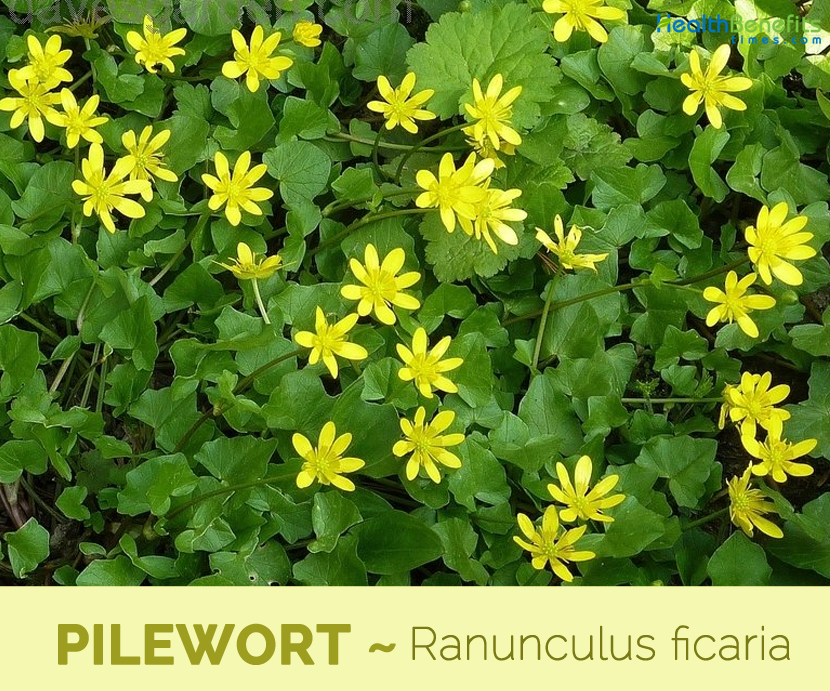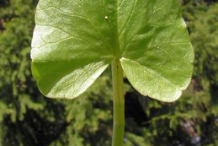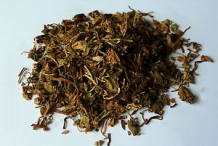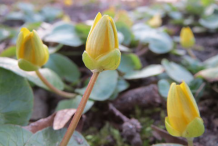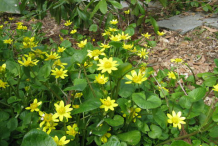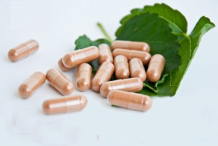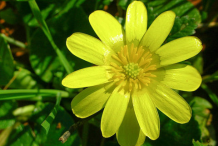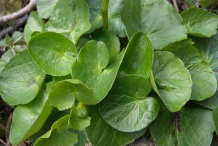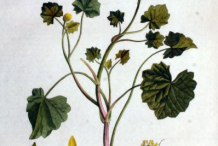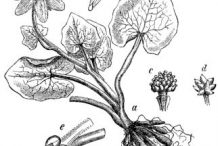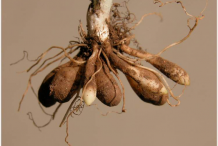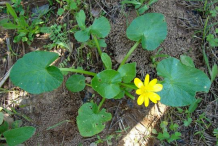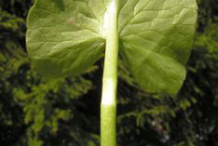| Pilewort Quick Facts |
| Name: |
Pilewort |
| Scientific Name: |
Ranunculus ficaria |
| Origin |
Central Europe, north Africa and the Caucasus |
| Shapes |
Hairy, approx. 2.5 mm (0.1) long achene, tip with short bristle. |
| Taste |
Bitter |
| Health benefits |
Beneficial For Piles and Treat scurvy |
Pilewort (Ranunculus Ficaria) medicinal herb also referred to as Fireweed, Double Lesser Celendine, Pilewort, Fig Buttercup, Small Celandine, Butterblume, Figwort, Smallwort, Tree Celandine, Celandine Poppy, is a perennial herbaceous plant used as herbal medicine since ancient times. It is a low growing flowering plant in the buttercup family Ranunculaceae. Pilewort is native to Europe and eastern Asia. It was introduced into North America many years ago (seemingly for ornamental purposes), but has now naturalized in 19 states in the Northeast, the Pacific Northwest and eastern Canada. Genus name comes from a medieval plant name probably from Ficus (fig) in reference to tubers somewhat resembling figs.
The plant is poisonous if ingested raw and possibly fatal to grazing animals and livestock such as horses, cattle, and sheep. For these reasons, several US states have banned the plant or listed it as a noxious weed. The leaves turn poisonous as the fruit matures. Young leaves are consumed raw or cooked as a potherb in spring.
Plant
Pilewort is a low-growing, hairless perennial herbaceous spring ephemeral plant that grows about 10–30 cm (4–12 in.) tall. It can be found growing in a range of habitats, including woodlands, hedgerows, churchyards, road verges, meadows, in gardens and waste ground and on Stream banks, seaside broad-leaved forests, waterside meadows, hedgerows, coppices, parks and yards. The plant prefers soil that contains loam, silt, or calcareous sand. The plant has thick tuberous roots that are up to 3 cm long. Stems are erect (sometimes ascending), branched, glabrous. Tiny cream colored bulblets are produced in stem axils and become apparent later in the flowering period. Abundant finger like tubers are produced by the roots and are easily visible when plants are pulled up.
Leaves
The plant has alternate, long-stalked, glabrous, shiny, kidney to heart shaped lustrous dark green leaves that form a rosette with smooth to coarse toothed edges. Blade is widely ovate–triangular shaped.
Flower & Fruit
Flower consists of eight glossy, butter-yellow petals that are arranged in a rosette form and are seen singly on delicate stalks rising above the leaves. The outer petals are 8-10 and inner petals are paired. And the center of the flower has tiny flowers, which are very inconspicuous. Flowering occurs from Mar to May. Pilewort flowers are yellow, turning white as they age. Fruit is hairy, approx. 2.5 mm (0.1) long achene, tip with short bristle. Achenes are often undeveloped.
Flowers shut up before rain and even in fine weather do not open before nine o’clock, and by 5 p.m. have already closed for the night. The Celtic name of the plant, Grian (i.e. the sun), refers to this habit. The petals are green on the underside, and directly the flowers close they become inconspicuous. Flowers are sometimes referred as spring messenger. When in bloom, large infestations of pilewort appear as a green carpet with yellow dots, spread across the forest floor.
Health Benefits of Pilewort
Pilewort is a common name for plants that were traditionally used to treat piles. (Hemorrhoids) This herb was more commonly used throughout the Tudor period in England. Following are few of the health related benefits of Pilewort:
1. For Piles
Since ancient times, Pilewort has been used to treat piles or hemorrhoids. The herb can be used externally as well as internally to treat piles. Internally, the roots of the plant are used to make herbal tea. This practice is usually seen in folk medicine.
Externally, poultices containing the crushed extract of the herb along with crushed ice are applied directly to the affected area. Many use Pilewort along with aloe Vera and make a cream using this combination for external application.
Pilewort helps in reducing the pain associated with hemorrhoids. It is said that the herb effectively helps in constricting the blood vessels and reduces bleeding.
2. Anti-fungal
Fresh lesser celandine consists of the phytochemical protoanemonin, which has a fungicidal action. The dried plant does not contain protoanemonin.
3. Treat scurvy
In the past the young leaves, which are rich in vitamin C, were eaten as salad and used to treat scurvy. Older leaves cannot be used because they contain the toxin protoanemonin. The buds of lesser celandine have been used as a substitute for capers.
4. Other Benefit
Apart from treating piles and the terrible pain accompanying the condition, Pilewort is also is used to treat perineal tears caused during childbirth in women.
https://www.youtube.com/watch?v=6yhlG3aPVmE
Traditional uses and benefits of Pilewort
- Lesser celandine has been used for thousands of years in the treatment of hemorrhoids and ulcers.
- Doctors recommend that pilewort could be used to cure piles.
- Leaves are high in vitamin C thus helps to prevent scurvy.
- Whole plant, including the roots, is astringent.
- An infusion can be taken internally or it can be made into an ointment and used externally.
- It is also applied externally to perineal damage after childbirth.
- Most excellent ointment has been recommended for external abscesses, etc., made from Pilewort, Elder-buds, House-leek, and leaves of the Broad Plantain, prepared in the early spring, when the Pilewort is in flower.
- Roots are highly valued as a medicine in Cochin-China.
- It is very excellent as an alternative remedy for diseases of the mucous membrane, colon conditions, fevers, cholera as well as dysentery.
- It is also an excellent blood purifier.
- It is good for children in the sense that it can help to alleviate diarrhea.
- It can also be used in conjunction with St. John’s wort to relieve itching and burning of hemorrhoids.
- Externally, it is used for muscular rheumatism, sciatica.
- Tincture of the fresh whole plant is used for diarrhea, gonorrhea, hemorrhage, Metrorrhagia, and orchitis.
- Pilewort ointment is used to be applied to corns and warts.
Culinary Uses
- Young leaves are consumed raw or cooked as a potherb in spring.
- First leaves in spring make an excellent salad.
- Leaves, stalks and buds can be used like spinach, whilst the blanched stems are also eaten.
- Bulbils can be cooked and used as a vegetable.
- Flower buds make a good substitute for capers.
- Small bulbils of the root are cooked for a few minutes in boiling water, and then served with olive oil and course sea salt.
- The bulbils can be fried or boiled, and the tubers can be boiled or roasted as well.
Other facts
- Leaves turn poisonous as the fruit matures.
- Flower petals are an effective tooth cleaner.
- Plant often forms dense carpets when grown in the shade and can therefore be used as a ground cover though they die down in early summer.
- Leaves and flowers arise on separate stems.
- Blossoms close before rain, and even in fine weather do not open before 9 a.m., and by 5 p.m. they are closed for the night.
- Celandine flowers are sometimes referred as spring messenger.
- In shady places the leaves develop bulbils at the base of the stalk.
- Celandine flowers are yellow, turning white as they age.
Precautions
- All parts of the plant are poisonous.
- Toxins are unstable and of low toxicity, they are easily destroyed by heat or by drying.
- Sap can cause irritation to the skin.
- It is not recommended for internal use because it contains several toxic components.
- Stop using the herb if you have breathing problems or chest & throat tightness.
- Some caution is advised because it can cause irritation to sensitive skins.
- It may cause liver damage.
- Avoid use during pregnancy and breast feeding.
- In large doses it produces vomiting.
References:
https://www.itis.gov/servlet/SingleRpt/SingleRpt?search_topic=TSN&search_value=18603#null
https://davesgarden.com/guides/pf/go/62509/
http://www.pfaf.org/User/Plant.aspx?LatinName=Ranunculus+ficaria
https://www.cabi.org/isc/datasheet/116662
https://www.botanical.com/botanical/mgmh/c/celles44.html
https://plants.usda.gov/core/profile?symbol=RAFI
http://www.missouribotanicalgarden.org/PlantFinder/PlantFinderDetails.aspx?taxonid=368056&isprofile=0&pt=8
http://www.theplantlist.org/tpl1.1/record/kew-2809356
http://medicinalherbinfo.org/herbs/Pilewort1.html
https://en.wikipedia.org/wiki/Ficaria_verna
https://www.invasivespeciesinfo.gov/plants/figbuttercup.shtml
Comments
comments


